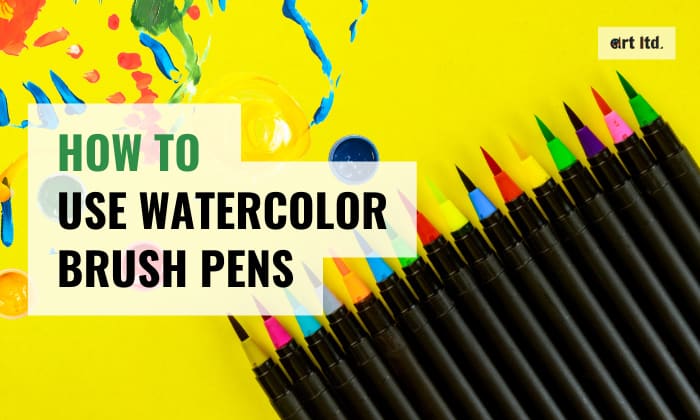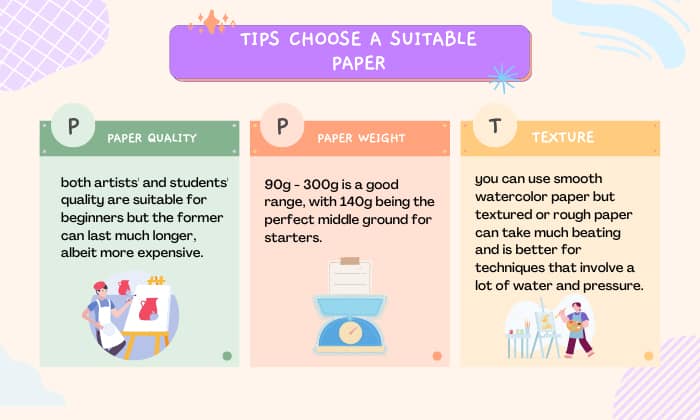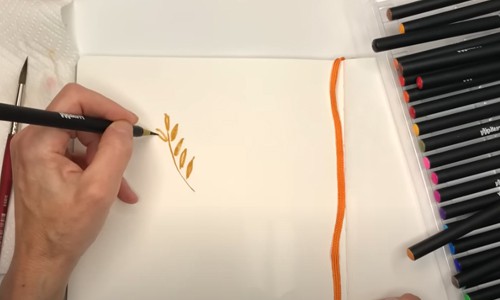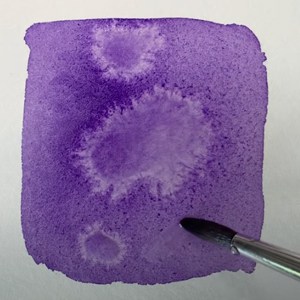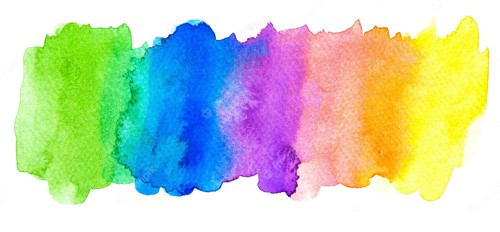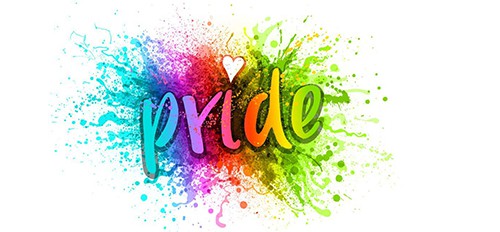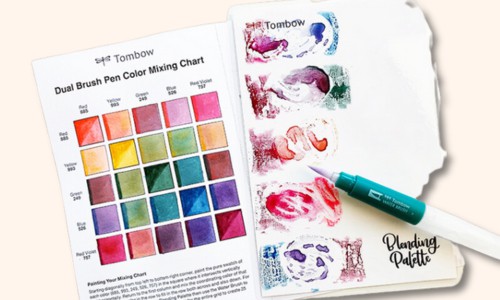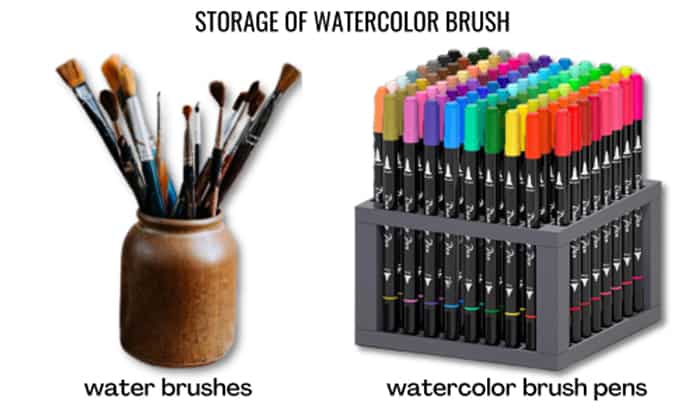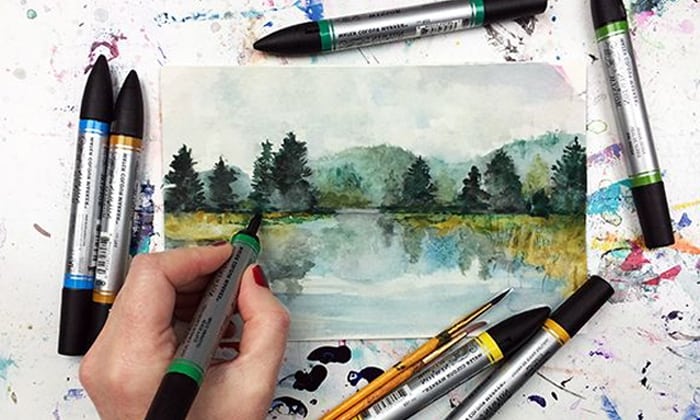Watercolor brush pens are one of the few art materials that are practical, versatile, and a joy to work with. These pens feature a built-in brush and premixed colors. In short, they are ready to use. That said, if you still find the art tool hard to work with, then this article is right for you.
Explore the basic steps of how to use watercolor brush pens and the different techniques you can use to maximize their potential right here.
Table of Contents
Watercolor Brush Pen Guide
1. Choose a suitable paper
The type of paper you are using could make or break your watercolor artwork, so consider the three following aspects:
- Paper quality: both artists’ and students’ quality are suitable for beginners but the former can last much longer, albeit more expensive.
- Paper weight: 90g – 300g is a good range, with 140g being the perfect middle ground for starters.
- Texture: you can use smooth watercolor paper but textured or rough paper can take much beating and is better for techniques that involve a lot of water and pressure.
2. Swatch your colors
The best way to see the true colors and range of your brush pens is to swatch them. This will likewise give you an impression and actual feel of how it works.
On a piece of paper, draw several small squares and write down the name or color code of each brush pen in their corners. Then apply the color to a small section of the square to see how it’d look on paper. Afterward, use a colorless blender around the pigment to get an idea of how the hue will change.
3. Decide if you need to prime or not
If you want a smoother finish or color a big background, prime your paper with water. In contrast, if you like the rough edges or you want to create a contrast, priming won’t be necessary.
To prime, dip a sponge roller brush into water and squeeze out the excess. When done, roll the brush horizontally across the paper all the way down, then switch to rolling vertically from one side to another.
4. Explore other tools and start coloring
Practice coloring using watercolor brush pens on a coloring book and try to learn different techniques.
Look for inspiration or a watercolor brush pens tutorial. Try using other tools such as water brushes and other coloring mediums.
Basic Techniques
1. Direct Application
For a solid and vibrant block of color, you can just apply the color directly onto the paper without any priming beforehand. Should you want a lighter and smoother finish in certain sections of your artwork, you can lightly dip the brush into water.
2. Layering
This technique is done by applying one color and letting it dry first before applying another layer. You can use one color and build it up by layering. Using lines, dots, and patterns is likewise applicable.
3. Water Bloom
While the color is still slightly wet, gently squeeze the brush pen’s barrel to dispense one drop of water (or a diluted color of choice) onto the desired area. This will cause the color to “bloom,” giving the artwork more visual interest.
Blending Effects
1. Direct Blending
Similar to an alcohol marker, you can use watercolor brush pens to blend colors together without needing any help. To smoothen the transition, use the lighter tone to blend over the dark one. This works best when the two tones are in the same color family.
2. Blending With Water
With this method, you can use as many colors as you like. After all the colors are laid, blend them using a water brush while the colors aren’t fully dried. That said, do not worry if you catch them drying; the water brush can still blend them in.
3. Ombre
You can achieve this effect by applying and blending color puddles on a ceramic or a plastic palette before applying them to your paper.
Another way is to use the tip-to-tip method, where you let the color of one pen transfer to the other by touching the two pens’ tips together. To get a strong combination, pick one light color and partner it with a darker one.
Advanced Techniques to Create Strong Contrast and Textures
There are different ways to create unique textures. If you are using textured paper, you can easily emphasize it by coloring the area with a dry and flat tip. Exert more pressure than you usually do to spread the tip.
You can also use other tools, such as salt. Simply sprinkle a small amount of salt over your wet watercolor paint; remove the salt as soon as it starts melting. This will leave your piece with small crystal-like patterns.
Additional Tips and Tricks
A water brush is your best friend. They are the perfect tool for you to put mixed media into play. Make the most of them with the following ideas:
- Use them to apply other coloring mediums to your drawing. Press a wet water brush against a water-soluble crayon to pick up colors.
- If you color with watercolor pencils, you can use the water brush to smoothen their pigment.
- When you still have leftover watercolor paints on palettes, you do not need to go back to using traditional brushes. Use a water brush instead.
Choosing Watercolor Brush Pens
1. Color Options and Watercolor Sets
Although you can easily blend watercolor brush pens to produce different colors, it is always better to have a wider color palette. This will protect you from scenarios where you can’t get the effect you want because you don’t have the right colors.
You can go for watercolor sets like the Tombow Watercoloring set, which already includes a wide range of hues and everything you need to get started.
Most famous brands also offer dual-ended types like the Staedtler watercolor brush pens, which give you 2 different tip sizes for more versatility.
2. Tip Types and Character
The tip type can greatly affect the way your artwork turns out. Some tips may come dry, while others could be juicy straight from the box.
Dry tips are good for direct application and detailing, while juicy tips are easier to blend and ideal for coloring large areas.
The tips can either be made with felt or nylon like a typical paintbrush. Felt tips are more consistent than the nylon variety, but if you are used to using paint brushes, the nylon option could be the closest you can get.
Maintenance and Storage of Watercolor Brush Pens
Another advantage of watercolor brush pens is that they are easy to maintain. Watercolor brush markers and pens can be stored in bins, nooks, and shelves in any position.
However, some brands like Arteza recommend storing the Arteza Real brush pens upright with nibs pointing downwards. So you should always check the product’s instructions to see if there are any specific requirements.
For colored watercolor brush pens, you have to keep their caps closed after every use. In addition, you would want to keep them in a cool and dry place to avoid ink from drying out.
For water brushes, be sure to clean the inner part and the tip with water. If they have bristle tips, gently smoothen the bristles using your fingers or a paper towel. Keep them dry before storage.
FAQs
Why use watercolor brush pens?
Aside from being fun to work with, watercolor brush pens have good qualities you can take advantage of, such as:
- They are odorless and non-toxic.
- They’re easy to clean and you usually do have to worry about getting stained.
- Watercolor brush pen art is still workable even after drying.
- They are very handy.
Can you use watercolor brush pens for calligraphy?
Yes, absolutely! The brush tip is a good tool for calligraphy and other lettering techniques. Watercolor brush pens have flexible tips that produce different thickness that is perfect for creating various calligraphy strokes.
The ink of these pens is also transparent and layer-able, so you can create different gradients. However, since they are water-based, they take longer to dry than regular calligraphy pens.
What is the difference between brush pens and Watercolour brush pens?
Simply put, watercolor brush pens are a type of brush pen. You can classify them into two smaller categories: non-refillable and refillable watercolor brush pens.
Moreover, what makes watercolor brush pens different from other brush pens is that they do not emit strong odors and do not contain harmful solvents due to their water-based ink.
Conclusion
Learning how to use watercolor brush pens is simple and does not vary much from using traditional watercolors.
There are plenty of techniques you can enjoy, even if you are still a beginner. Plus, these brush pens are easy to maintain and can be used alongside other mediums.
Have a great time experimenting with your watercolor brush pens!

Art has always been a part of my life; it influences my upbringing and later my career choice. For me, it is always a part of my parenting technique. So for whichever purpose that you come to art, you can start here with us.
